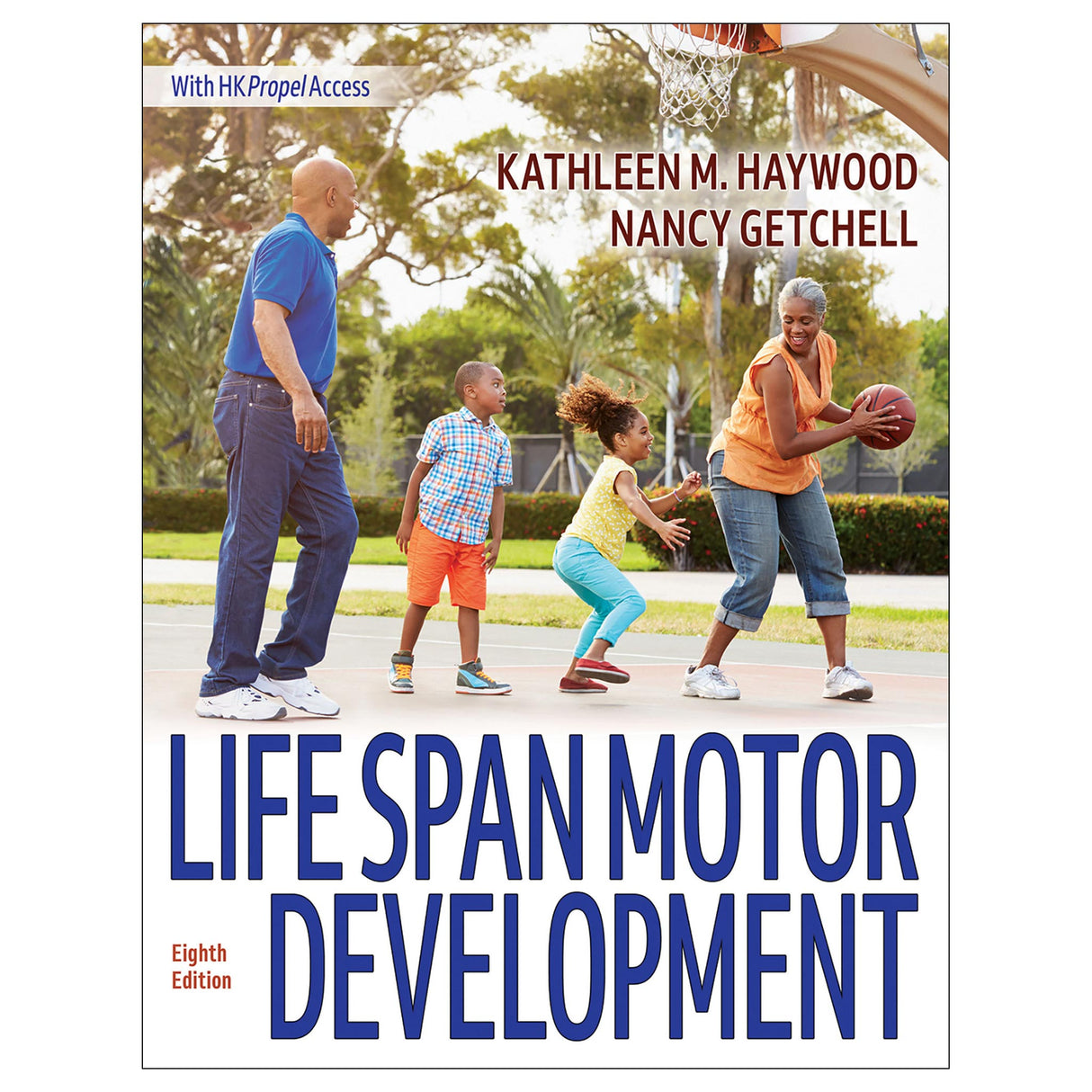Life Span Motor Development 8th Edition Ebook With HKPropel Access
Author: Kathleen M. Haywood, Nancy Getchell
$140.95 CAD

Life Span Motor Development helps students understand how maturational age and chronological age are distinct and how functional constraints affect motor skill development and learning. It shows how the four components of physical fitness—cardiorespiratory endurance, strength, flexibility, and body composition—interact to affect a person’s movements over the life span, and it describes how relevant social, cultural, psychosocial, and cognitive influences can affect a person’s movements. It also now includes more content on atypical development; new Spotlight on Disability sidebars help readers use the constraints perspective to better understand how various disabilities influence motor development.
The eighth edition continues the tradition of making the student’s experience with motor development an interactive one. Related online learning tools delivered through HKPropel include an updated video library with more than 200 video clips, showing motor development milestones, to sharpen observation techniques; flash cards; key term quizzes; and 48 lab activities (including one new to this edition) to facilitate critical thinking and hands-on application. Some lab activities may be assigned and tracked by instructors through HKPropel, and sample answers for the lab activities are found in the instructor guide. Chapter quizzes are automatically graded to test comprehension of critical concepts.
This edition features updated, modernized artwork and includes 142 illustrations, 60 photos, and 24 tables—all in full color—to help explain concepts and to make the text more engaging for students. It also retains helpful learning aids, including chapter objectives, a running glossary, key points, sidebars, and application questions throughout the text. Each chapter begins with a section titled Motor Development in the Real World, which presents realistic experiences that help readers connect with the material. Each chapter ends with a section titled Reinforcing What You Have Learned About Constraints, which prompts readers to answer questions about the material and complete learning exercises. Answers to these questions are included in the instructor guide.
Life Span Motor Development, Eighth Edition, embraces an interactive and practical approach to illustrate the most recent research in motor development. Students will come away with a firm understanding of the concepts and how they apply to real-world situations.
Note: A code for accessing HKPropel is included with this ebook.
Audience
A textbook for undergraduate courses on motor development. Also a reference for researchers in motor behavior and motor development as well as practitioners in physical and occupational therapy, physical education, and rehabilitation.Chapter 1. Fundamental Concepts
Defining Motor Development
Constraints: A Model for Studying Motor Development
How Do We Know It Is Change?
A Developmental Paradox: Universality Versus Variability
Summary and Synthesis
Chapter 2. Theoretical Perspectives in Motor Development
Maturational Perspective
Information Processing Perspective
Ecological Perspective
Current Interests
Summary and Synthesis
Chapter 3. Principles of Motion and Stability
Understanding the Principles of Motion and Stability
Using the Principles of Motion and Stability to Detect and Correct Errors
Summary and Synthesis
Part II. Development of Motor Skills Across the Life Span
Chapter 4. Early Motor Development
How Do Infants Move?
Why Do Infants Move? The Purpose of Reflexes
Motor Milestones: The Pathway to Voluntary Movements
Development of Postural Control and Balance in Infancy
Summary and Synthesis
Chapter 5. Development of Human Locomotion
The First Voluntary Locomotor Efforts: Creeping and Crawling
Walking Across the Life Span
Running Across the Life Span
Other Locomotor Skills
Summary and Synthesis
Chapter 6. Development of Ballistic Skills
Overarm Throwing
Kicking
Punting
Sidearm Striking
Overarm Striking
Interventions
Summary and Synthesis
Chapter 7. Development of Manipulative Skills
Grasping and Reaching
Catching
Anticipation
Summary and Synthesis
Part III. Physical Growth and Aging
Chapter 8. Physical Growth, Maturation, and Aging
Prenatal Development
Postnatal Development
Summary and Synthesis
Chapter 9. Development and Aging of Body Systems
Systems Development During the Prenatal Period
Systems Development During Childhood and Adolescence
Systems Development During Adulthood and Older Adulthood
Summary and Synthesis
Part IV. Development of Physical Fitness
Chapter 10. Development of Cardiorespiratory Endurance
Physiological Responses to Short-Term Exercise
Physiological Responses to Prolonged Exercise
Summary and Synthesis
Chapter 11. Development of Strength and Flexibility
Muscle Mass and Strength
Development of Strength
Development of Flexibility
Summary and Synthesis
Chapter 12. Weight Status, Fitness, and Motor Competence
A Model of Interrelationships
Body Composition
Obesity
Motor Competence, Activity, Fitness, and Body Composition
Summary and Synthesis
Part V. Perceptual-Motor Development
Chapter 13. Sensory-Perceptual Development
Visual Development
Kinesthetic Development
Auditory Development
Intermodal Perception
Summary and Synthesis
Chapter 14. Perception and Action in Development
The Role of Action in Perception
Postural Control and Balance
Summary and Synthesis
Part VI. Functional Constraints in Motor Development
Chapter 15. Social and Cultural Constraints in Motor Development
Social and Cultural Influences as Environmental Constraints
Other Sociocultural Constraints: Race, Ethnicity, and Socioeconomic Status
Summary and Synthesis
Chapter 16. Psychosocial Constraints in Motor Development
Self-Esteem
The Link Between Perceived and Actual Motor Competence
Motivation
Summary and Synthesis
Chapter 17. Developmental Motor Learning
Unpacking the Definition of Motor Learning
Stages of Learning and the Development of Expertise
Practice and Motor Learning
Augmented Feedback and Motor Learning
Other Factors That Influence Motor Learning
Summary and Synthesis
Chapter 18. Conclusion: Interactions Among Constraints
Using Constraints to Enhance Learning in Physical Activity Settings
Interacting Constraints: Case Studies
Summary and Synthesis
Appendix. Skinfold, Body Mass Index, and Head Circumference Charts
Development of the skeletal system during childhood and adolescence
Stages of learning new motor skills: Bernstein’s model




All ancillaries are free to adopting instructors through HKPropel.
Instructor guide. Includes chapter overviews and major concepts, suggested answers to the Test Your Knowledge questions found in the text, supplemental class activities, background readings, sample answers for lab activities, and additional open-ended questions.
Test package. Contains 588 questions in true-false, fill-in-the-blank, essay and short-answer, and multiple-choice formats. The files may be downloaded for integration with a learning management system or printed for use as paper-based tests. Instructors may also create their own customized quizzes or tests from the test bank questions to assign to students directly through HKPropel. Multiple-choice and true-false questions are automatically graded, and instructors can review student scores in the platform.
Chapter quizzes. Contains ready-made quizzes (9-10 questions each) to assess student comprehension of the most important concepts in each chapter. Each quiz may be downloaded or assigned to students directly through HKPropel. The chapter assessments are automatically graded, and instructors can review student scores in the platform.
Presentation package. Features 569 PowerPoint slides of text, artwork, and tables from the book that can be used for class discussion and presentation. The slides in the presentation package can be used directly within PowerPoint or printed to make handouts for students. Instructors can easily add, modify, and rearrange the order of the slides.
Image bank. Includes most of the figures, content photos, and tables from the text, sorted by chapter. These can be used in developing a customized presentation based on specific course requirements.
Online videos. Features all the videos available to students through HKPropel in separate files for instructors so they can be uploaded into learning management systems or PowerPoint presentations.
Instructors also receive access to all student materials in HKPropel. For Life Span Motor Development, this includes lab activities that can be filled in online and printed or emailed and over 200 video clips with footage focusing on infants, toddlers, young children, adolescents, and adults performing fundamental motor skills, including a comprehensive video diary of the first nine months of an infant’s life. Lab activities and interactive questions give students an opportunity to apply concepts from the book, sharpening their observation skills and providing an integrated student learning experience.






